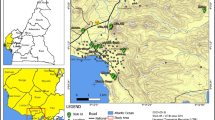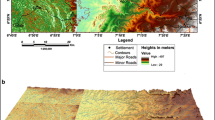Abstract
The new express highway linking Enugu (in Enugu State) and Onitsha (in Anambra State) both in Southeastern Nigeria, is plagued with landslides, a few years after completion. The active landslides are concentrated on the road cuttings between Otuocha junction and Awka, specifically between km 29 and km 40 from the Onitsha end of the road. Three of these slides have been studied.
The investigation involved detailed field and laboratory studies of the physical conditions and geotechnical properties of the sites and soils therein. The laboratory tests performed included grainsize distribution analysis, Atterberg limits, specific gravity, natural water content, bulk density, permeability and shear strength.
Each site was analysed for stability using the strength parameters obtained from laboratory tests and Bishop's 1955 simplified method of analysis. There is evidence from the analyses results that although the cut slopes are vulnerable to toe undermining and over-steepening by runoff, the generally “loose” nature of the soils as evidenced by the low bulk density (1580–1960 kg/cm3), fairly high void ratio (0.53–0.66) but low permeability (2.15–3.25×10−3 cm/s) and consequent high saturation and strength reduction during the rains, are the major contributors to instability of the cut slopes.
Résumé
La nouvelle route express qui relie Enugu à Onitsha dans le Sud-Ouest du Nigéria est affectée de nombreux glissements de terrain, quelques années seulement après sa construction. Les glissements actifs sont concentrés sur une dizaine de kilomètres, à proximité d'Onitsha. Trois d'entre eux ont été étudiés.
Pour chacun ont été réalisés une étude de terrain détaillée et des essais de laboratoire comprenant des analyses granulométriques, limites d'Atterberg, masse volumique, teneur en eau, perméabilité et résistance au cisaillement. L'étude de stabilité de chaque site a été réalisée en utilisant les paramètres de résistance et la méthode d'analyse simplifiée de Bishop (1955). Les analyses montrent que les pentes des déblais sont sensibles à l'affouillement en pied et surtout que la nature «meuble» des sols, bien mise en évidence par la faible masse volumique (1 580–1 960 kg/cm3), l'indice des vides (0,53–0,66), la faible perméabilité (2,15–3,25×10−3 cm/s) et le fort degré de saturation et de réduction de résistance qui en découlent pendant les pluies sont les causes principales de l'instabilité des pentes de déblais.
Similar content being viewed by others
References
BISHOP A.W., 1955: The use of the slip circle in the stability analysis of slopes. Geotechnique, 5: 7–17.
BUIST D.S., BURNETT A.D. and SANDERS M.K., 1979: Engineering Properties and slope stability of lower coal measure rocks from Monkwood Cutting, Unstone-Dronfield, By-Pass, Derbyshire. Engr. Geol. 14: 11–28.
CAMPBELL R.H., 1974: Debris flows originating from soil slips during rain storms in Southern California. Quart. Jour. Eng. Geol. 7: 339–347.
CRUDEN D.M. and DE LUGT J., 1989: Towards a World Landslide Inventory. Presented at the 1st South American Conf. on Landslides, April 1989.
HOEK E. and BRAY J.W., 1981. Rock slope engineering. Inst. Mining and Metallurgy London.
International Geotechnical Societies' UNESCO Working Party on World Landslide Inventory (IGSWP) 1990. A suggested method for reporting a Landslide. Bull. Int. Assoc. Eng. Geol., 41: 5–12.
LAMBE T.W., 1951: Soil testing for engineers John Wiley and Sons. New York.
OJULARI A.Y., 1979: Instability investigations of some residual soil slopes in road cuts around Lokoja, Nigeria. Bull. Int. Assoc. Eng. Geol. 17: 118–123.
OKAGBUE C.O. and EZECHI J.I., 1988: Geotechnical characteristics of soils susceptible to severe gullying in Eastern Nigeria. Bull. Int. Assoc. Engl. Geol. 38: 111–119.
SKEMPTON A.W., 1953: Soil Mechanics in relation to geology. Proc. Yorkshire Geological Society, 29 Pt. 1(3): 33–62.
SKEMPTON A.W. and HUTCHINSON J.N., 1969: Stability of natural slopes and embankment foundations. Proc. 7th Int. Conf. Soil Mech. Found. Eng. Suppl. State of the art vol. Mexico: 291–340.
SPENCER E., 1967: A method of analysis of the stability of embankments assuming parallel interslice forces. Geotechnique 17(1): 11–26.
WHITMAN R.V. and BAILEY W.A., 1967: Use of computers for slope stability analysis. Jour. Soil Mech. Found. Div. ASCE Proc. 93, SM4: 475–498.
Author information
Authors and Affiliations
Rights and permissions
About this article
Cite this article
Okagbue, C.O., Ifedigbo, O.T. Engineering properties and slope stability of road cuttings along the enugu-onitsha express road, Southeastern Nigeria. Bulletin of the International Association of Engineering Geology 52, 85–93 (1995). https://doi.org/10.1007/BF02602685
Published:
Issue Date:
DOI: https://doi.org/10.1007/BF02602685




